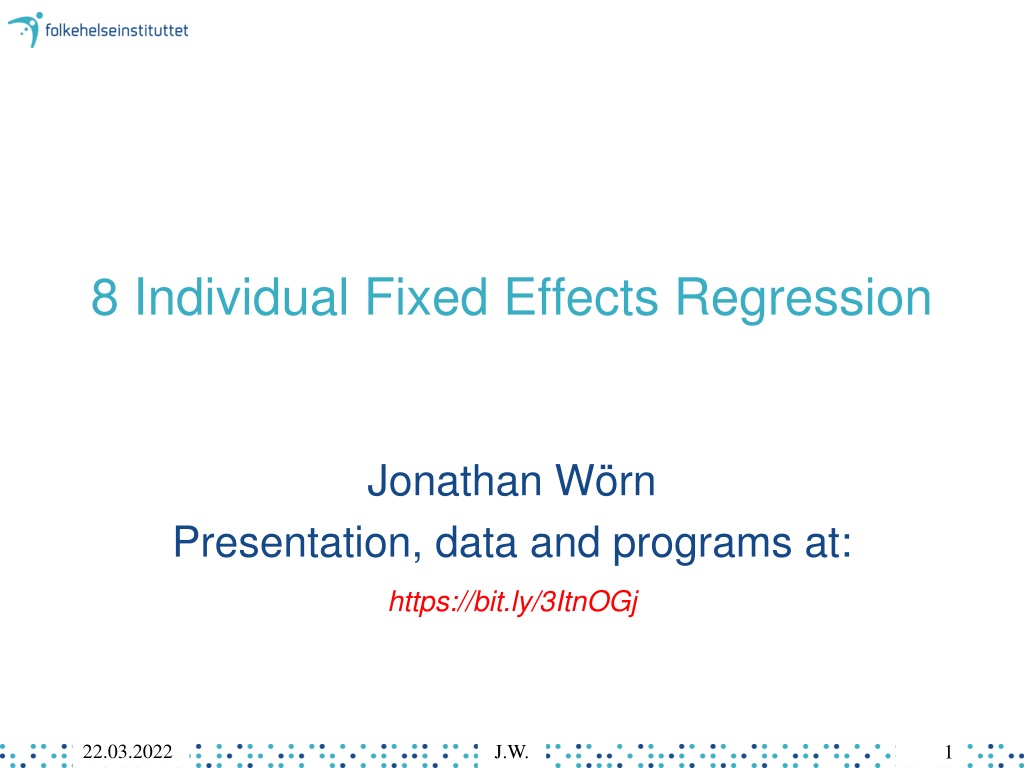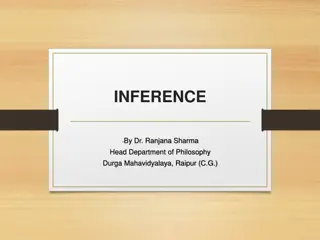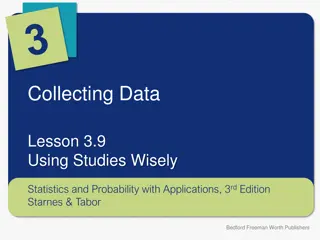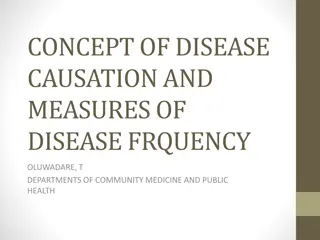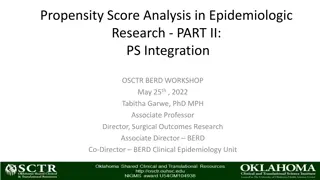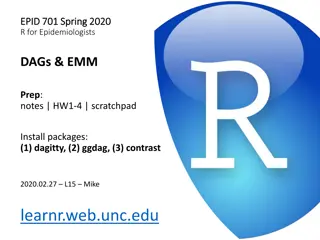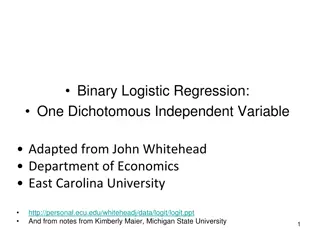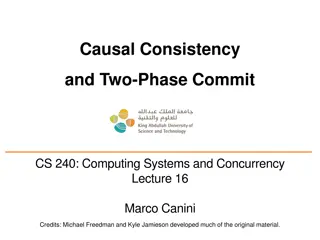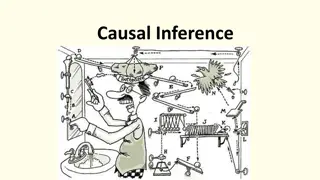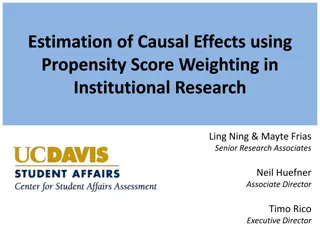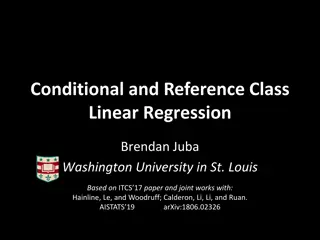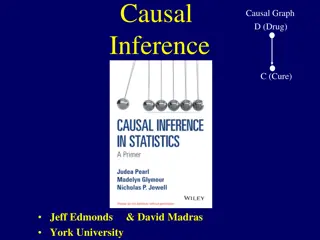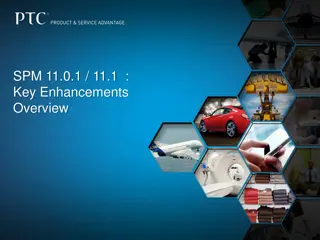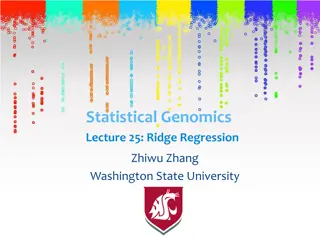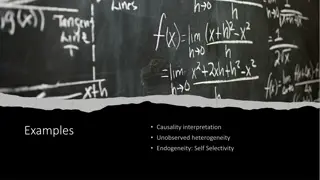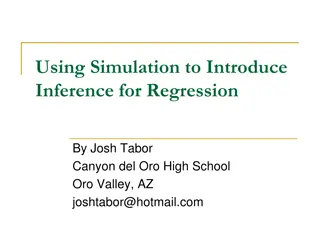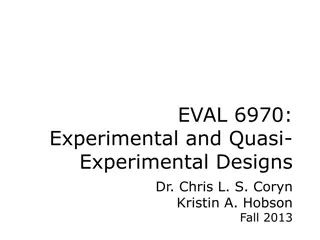Understanding Fixed Effects Regression for Causal Inference in Social Research
Explore the concept of fixed effects regression for obtaining causal estimates with observational data, focusing on the association between social participation and depressive symptoms. Discover how this method controls for time-invariant factors and eliminates confounding variables, providing a closer look at causal relationships. Examples and real-world applications illustrate the benefits of fixed effects analysis in social science research.
Download Presentation

Please find below an Image/Link to download the presentation.
The content on the website is provided AS IS for your information and personal use only. It may not be sold, licensed, or shared on other websites without obtaining consent from the author. Download presentation by click this link. If you encounter any issues during the download, it is possible that the publisher has removed the file from their server.
E N D
Presentation Transcript
8 Individual Fixed Effects Regression Jonathan W rn Presentation, data and programs at: https://bit.ly/3ItnOGj 22.03.2022 J.W. 1
Todays menu: Fixed effects Idea & Examples Model & Assumptions Syntax, Interpretation, Sample Selection Getting the data in shape A real world example: Marriage & Happiness Concluding remarks Special thanks to Josef Br derl at Ludwig-Maximilians-University M nchen. Parts of this presentation are based on his excellent lecture materials: https://www.ls3.soziologie.uni-muenchen.de/downloads/downloads_lehre/teaching_materials/panelanalysis-bruederl.pdf 22.03.2022 J.W. 2
Idea & Examples 22.03.2022 J.W. 3
Fixed Effects A method to get closer to causal estimates with non- experimental, observational data Is change in X associated with change in Y? Repeated measures / panel data Rules out confounding from time-invariant factors Neither observed and unobserved factors 22.03.2022 J.W. 4
Examples 22.03.2022 J.W. 5
Examples 22.03.2022 J.W. 6
Examples 22.03.2022 J.W. 7
Idea Social participation and depressive symptoms 7 6 5 Depressive Symptoms 4 3 2 1 See Br derl (2015) 0 Year 1 Year 2 Year 3 Year 4 Year 5 Year 6 not treated treated 22.03.2022 J.W. 8
Idea Social participation and depressive symptoms 7 6 5 Depressive Symptoms 4 Cross-sectional regression 3 2 1 See Br derl (2015) 0 Year 1 Year 2 Year 3 Year 4 Year 5 Year 6 not treated treated 22.03.2022 J.W. 9
Idea Social participation and depressive symptoms 7 6 5 Depressive Symptoms 4 Fixed effects regression 3 2 1 See Br derl (2015) 0 Year 1 Year 2 Year 3 Year 4 Year 5 Year 6 not treated treated 22.03.2022 J.W. 10
Why not pooled OLS? Social participation and depressive symptoms 7 6 5 Depressive Symptoms 4 3 2 1 See Br derl (2015) 0 Year 1 Year 2 Year 3 Year 4 Year 5 Year 6 not treated treated 22.03.2022 J.W. 11
Model & Assumptions 22.03.2022 J.W. 12
Model Pooled linear regression for panel data ???= ? + ????+ ???,? = 1, ,?,? = 1, ? Biased estimates if ???(???,???) 0 Step 1: Splitting error into person-specific and time- specific components ???= ??+ ??? resulting in error components model ???= ????+ ??+ ??? 22.03.2022 J.W. 13
Model resulting in error components model ???= ????+ ??+ ??? Step 2: Between transformation (person-specific means over time t) ??= ? ??+ ??+ ?? Step 3: Within transformation = Fixed effect estimate (error component model between transformation) ??? ??= ? ??? ?? + (??? ??) ??drops out no confounding from time constant factors, even if ???(??,???) 0 22.03.2022 J.W. 14
Assumptions and Requirements Standard assumptions (linear regression) Loosend exogeneity assumption: No correlation of regressors with time-varying confounders: ? ???|??? = 0 Correlation of regressors with time-constant confounders is no problem: Consistent estimates even if ? ?|??? 0 Likely violated: Absence of autocorrelation Use cluster robust standard errors (Huber-White sandwich estimator) Also helps with heteroskedasticity No maturation or period effects Add control group. Necessary assumption: parallel trends Required: Temporal variation in predictor (and outcome) 22.03.2022 J.W. 15
Syntax, Interpretation, Sample Selection 22.03.2022 J.W. 16
Syntax xtreg depvar indepvars, fe vce(cluster id) xtreg, fe: FE-model vce(cluster id): robust standard errors Command requires prior xtset. See Getting the data in shape 22.03.2022 J.W. 17
Interpretation Observations Persons Correlation regressors and time constant, person-specific error ?? Stata adds back a constant See Hamilton (2005) (?????_?)2 sigma_u: standard deviation of the time constant, person-specific error ?? sigma_e: standard deviation of the time- and person-specific error ??? rho: fraction of unexplained variance due to differences between units/persons (intraclass correlation coefficient) 22.03.2022 ? ? = (?????_?)2+(?????_?)2 J.W. 18
Interpretation Descriptive interpretation After participating in social activities, respondents depressive symptoms are .92 units lower than before participating in social activities Always correct Causal interpretation Participating in social activities reduces respondents depressive symptoms by .92 units Correct if exogeneity assumption holds See Br derl (2015) 22.03.2022 J.W. 19
Effect-estimate: only treated units Only persons being treated contribute to effect-estimate M1: FE with 2 treated persons, 2 non-treated persons M2: FE with 2 treated persons M3: pooled OLS with 2 treated and 2 non-treated persons 22.03.2022 J.W. 20
Maturation and period effects Social participation and depressive symptoms 7 6 5 Depressive Symptoms 4 3 2 1 0 Year 1 Year 2 Year 3 Year 4 Year 5 Year 6 not treated treated 22.03.2022 J.W. 21
Maturation and period effects Coefficients will be biased by Time trends Age effects Period effects Wrongly attribute temporal effect to treatment Always include time and control group in the model! Control group: at risk but not treated Assumption: Parallel trends in treatment and control If different trends: biased estimates 22.03.2022 J.W. 22
Maturation and period effects Accounting for time: smaller coefficient for treatment M1: xtreg depr social, fe vce(cluster id) M2: xtreg depr social wave, fe vce(cluster id) M3: xtreg depr social i.wave, fe vce(cluster id) 22.03.2022 J.W. 23
Time constant variables Main effects of time-constant variables cannot be estimated by FE-model Not necessary, as confounding is whiped out with ?? Not logical to assume that a time constant variable causes a change in the outcome Possible: Interaction time-constant with time-varying variables Does the effect of a time-varying variable differ between different groups? See A real world example 22.03.2022 J.W. 24
Sample selection 1. Include only persons who can potentially change from the state of not being treated to the state of being treated In example: those not participating in social activities (yet) When studying effects of marriage: those not (yet) married 22.03.2022 J.W. 25
Sample selection 2. Think carefully how to handle persons that change to yet another state than treated later on In studies of marriage effects: never married married divorce Keep? Exclude the person completely? Exclude only time points ( observations ) while divorced, but keep while never married and married? (substantial considerations) 22.03.2022 J.W. 26
Sample selection 3. Exclude persons with only one observation They cannot provide a within estimation 4. Consider including a control group Those that are at risk / not treated AND will not be treated during the observation period Allows controlling for time/age 22.03.2022 J.W. 27
Problems not solved by FE-models Endogeneity reversed causality time-varying confounders Panel attrition associated with time-variant factors Selection into treatment Treatment effect on the treated 22.03.2022 J.W. 28
Getting the data in shape 22.03.2022 J.W. 29
Data format panelvar timevar Long data format Multiple lines per person Each line = 1 time point xtsetting long data xtreg, fe requires xtset xtset panelvar timevar [, options] 22.03.2022 J.W. 30
Digression: Transforming wide to long format . reshape long depr social, i(id) j(wave) (note: j = 1 2 3 4 5 6) Data wide -> long Number of obs. 4 -> 24 Number of variables 13 -> 4 j variable (6 values) -> wave xij variables: depr1 depr2 ... depr6 -> depr social1 social2 ... social6 -> social 22.03.2022 J.W. 31
Describing xtset-data Describe transitions between statuses: xttrans varname [, freq] freq-option gives numbers in addition to percentages 22.03.2022 J.W. 32
Describing xtset-data Describe variables: xtsum varlist Varies only between persons Varies only within persons Enough within- variation in treatment? More info about xtsum and its interpretation: https://www.stata.com/manuals/xtxtsum.pdf 22.03.2022 J.W. 33
Describing xtset-data Tabulate variables: xttab varlist Observation/timepoint-level Unit/person-level Also: distinct-command to identify IDs with certain features 22.03.2022 J.W. 34
Describing xtset-data Useful for patterns of missingness: xtdescribe [, width(#) patterns(#)] Width of participation patterns (default: 100) Patterns: maximum number of patterns (default: 9) 22.03.2022 J.W. 35
Useful commands for long data J.W. 36
Useful commands for long data bysort: repeat command on subsets Sort and execute for each id and each wave: bysort id wave Sort by id and wave, but execute by id: bysort id (wave) Counting: Running count: gen run = _n Overall count: gen count = _N egen: extensions to generate egen newvar = fcn(arguments) [, options] fcn: min(exp), max(exp), and many more 22.03.2022 J.W. 37
Useful commands for long data Powerful combinations: bysort id (wave) : gen round = _n (each person: number rows in correct order) bysort id : gen total = _N (each person: how many rows) 22.03.2022 J.W. 38
Useful commands for long data Goal: Finding first treatment, after treatment, ever treated 22.03.2022 J.W. 39
Useful commands for long data Goal: Finding first treatment, after first treatment, ever treated 1. First treatment: bysort id (wave) : gen first_social = sum(social == 1) == 1 & sum(social[_n - 1] == 1) == 0 Is 1 if condition is true: social is 1 in row _n and is not 1 in row _n-1 Is 0 otherwise. 2. After first treatment bysort id (wave) : gen after_social = sum(first_social) Running sum of first_social up until wave _n, for person i 3. Tagging all observations of persons ever treated bysort id : egen ever_social = max(social) Finds the maximum of social (0 or 1) for each person 22.03.2022 J.W. 40
A real world example: Marriage & Happiness 22.03.2022 J.W. 41
A real world example Does marriage make happy? Based on a 50%-subsample from the German Family Panel 11 waves (2009-2019) 12.000 respondents, plus their partners, children, and parents Born 1971-73, 1981-83, 1991-93 und 2001-03 https://www.pairfam.de/ Log-file with syntax and output is available on course homepage For data access: Fill in data access form and send to me: https://www.pairfam.de/fileadmin/user_upload/ uploads/Covid-19/Antragsformular/ DistributionTeachingVersion_pairfam11.0 _COVID-19_en.pdf 22.03.2022 J.W. 42
Interaction with constant variables Effect of married when male == 0 (i.e., for women) Not estimated b/c constant over time DIFFERENCE in effect of married between men vs. women (n.s.). Effect of being married for men: 0.0268+(-0.0383)=-0.0114 22.03.2022 J.W. 43
Impact functions using dummies Controlling for wave-dummies Not controlling for wave-dummies Dummy variables indicating years since marriage Factor-notation in Stata Set variable years since marriage to a constant value (e.g. 10000) instead of missing included in model as control group Plot: coefplot-ado See 9-fixed-effects-regression_example.do / .smcl 22.03.2022 J.W. 44
Impact functions using dummies See 9-fixed-effects-regression_example.do / .smcl 22.03.2022 J.W. 45
Concluding remarks 22.03.2022 J.W. 46
Application to other data structures Applicable to other panel data structures Children in families Children in schools Areas within countries Model will exploit the variation within families (different children) schools (different children) countries (different areas) and whipe out specifics of families, schools, countries, etc 22.03.2022 J.W. 47
Summary individual fixed effects Approaching causality with panel data Uses within-variation Controls time-constant factors xtset and xtreg, fe vce(cluster id) Model Include those not treated at outset Include control group and control for time 22.03.2022 J.W. 48
References Allison, P.D. (2009). Fixed effects regression models. SAGE Publications, doi.org/10.4135/9781412993869 Best, H., & Wolf, C. (Eds.) (2014). The SAGE handbook of regression analysis and causal inference. SAGE Publications, doi.org/10.4135/9781446288146 Br derl, J. (2015). Applied Panel Data Analysis Using STATA. Course Material, available at https://www.ls3.soziologie.uni- muenchen.de/downloads/downloads_lehre/teaching_materials/panelanalysis-bruederl.pdf Gould, W.G. (n.d.). How can there be an intercept in the fixed-effects model estimated by xtreg, fe?, available at https://www.stata.com/support/faqs/statistics/intercept-in-fixed-effects-model/ Gunasekara, F.I., K. Richardson, K. Carter, T. Blakely. Fixed effects analysis of repeated measures data, International Journal of Epidemiology, Volume 43, Issue 1, February 2014, Pages 264 269, https://doi.org/10.1093/ije/dyt221 Hamilton, L.C. (2005). Statistics with STATA. Thomson, Belmont. Torres-Reyna, O. (2007). Panel Data Analysis Fixed and Random Effects using Stata. Course Material available at https://www.princeton.edu/~otorres/Panel101.pdf Wooldridge, J.M. (2009). Introductory Econometrics: A Modern Approach. South-Western. ISBN: 9780324581621 22.03.2022 J.W. 49
